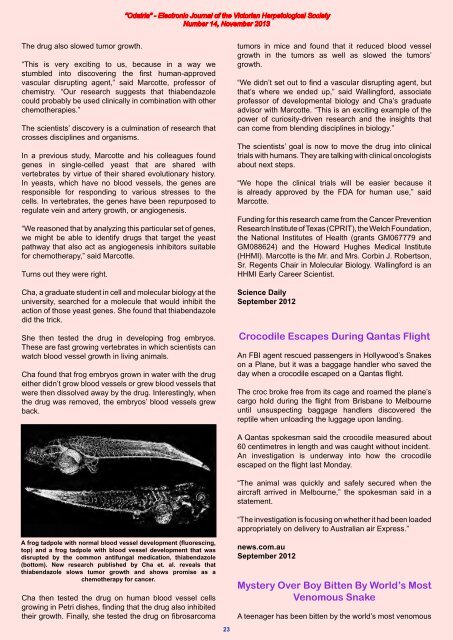Odatria_14_NOV13 - Victorian Herpetological Society
Odatria_14_NOV13 - Victorian Herpetological Society
Odatria_14_NOV13 - Victorian Herpetological Society
Create successful ePaper yourself
Turn your PDF publications into a flip-book with our unique Google optimized e-Paper software.
The drug also slowed tumor growth.“This is very exciting to us, because in a way westumbled into discovering the first human-approvedvascular disrupting agent,” said Marcotte, professor ofchemistry. “Our research suggests that thiabendazolecould probably be used clinically in combination with otherchemotherapies.”The scientists’ discovery is a culmination of research thatcrosses disciplines and organisms.In a previous study, Marcotte and his colleagues foundgenes in single-celled yeast that are shared withvertebrates by virtue of their shared evolutionary history.In yeasts, which have no blood vessels, the genes areresponsible for responding to various stresses to thecells. In vertebrates, the genes have been repurposed toregulate vein and artery growth, or angiogenesis.“We reasoned that by analyzing this particular set of genes,we might be able to identify drugs that target the yeastpathway that also act as angiogenesis inhibitors suitablefor chemotherapy,” said Marcotte.Turns out they were right.Cha, a graduate student in cell and molecular biology at theuniversity, searched for a molecule that would inhibit theaction of those yeast genes. She found that thiabendazoledid the trick.She then tested the drug in developing frog embryos.These are fast growing vertebrates in which scientists canwatch blood vessel growth in living animals.Cha found that frog embryos grown in water with the drugeither didn’t grow blood vessels or grew blood vessels thatwere then dissolved away by the drug. Interestingly, whenthe drug was removed, the embryos’ blood vessels grewback.tumors in mice and found that it reduced blood vesselgrowth in the tumors as well as slowed the tumors’growth.“We didn’t set out to find a vascular disrupting agent, butthat’s where we ended up,” said Wallingford, associateprofessor of developmental biology and Cha’s graduateadvisor with Marcotte. “This is an exciting example of thepower of curiosity-driven research and the insights thatcan come from blending disciplines in biology.”The scientists’ goal is now to move the drug into clinicaltrials with humans. They are talking with clinical oncologistsabout next steps.“We hope the clinical trials will be easier because itis already approved by the FDA for human use,” saidMarcotte.Funding for this research came from the Cancer PreventionResearch Institute of Texas (CPRIT), the Welch Foundation,the National Institutes of Health (grants GM067779 andGM088624) and the Howard Hughes Medical Institute(HHMI). Marcotte is the Mr. and Mrs. Corbin J. Robertson,Sr. Regents Chair in Molecular Biology. Wallingford is anHHMI Early Career Scientist.Science DailySeptember 2012Crocodile Escapes During Qantas FlightAn FBI agent rescued passengers in Hollywood’s Snakeson a Plane, but it was a baggage handler who saved theday when a crocodile escaped on a Qantas flight.The croc broke free from its cage and roamed the plane’scargo hold during the flight from Brisbane to Melbourneuntil unsuspecting baggage handlers discovered thereptile when unloading the luggage upon landing.A Qantas spokesman said the crocodile measured about60 centimetres in length and was caught without incident.An investigation is underway into how the crocodileescaped on the flight last Monday.“The animal was quickly and safely secured when theaircraft arrived in Melbourne,” the spokesman said in astatement.“The investigation is focusing on whether it had been loadedappropriately on delivery to Australian air Express.”A frog tadpole with normal blood vessel development (fluorescing,top) and a frog tadpole with blood vessel development that wasdisrupted by the common antifungal medication, thiabendazole(bottom). New research published by Cha et. al. reveals thatthiabendazole slows tumor growth and shows promise as achemotherapy for cancer.Cha then tested the drug on human blood vessel cellsgrowing in Petri dishes, finding that the drug also inhibitedtheir growth. Finally, she tested the drug on fibrosarcomanews.com.auSeptember 2012Mystery Over Boy Bitten By World’s MostVenomous SnakeA teenager has been bitten by the world’s most venomous23


